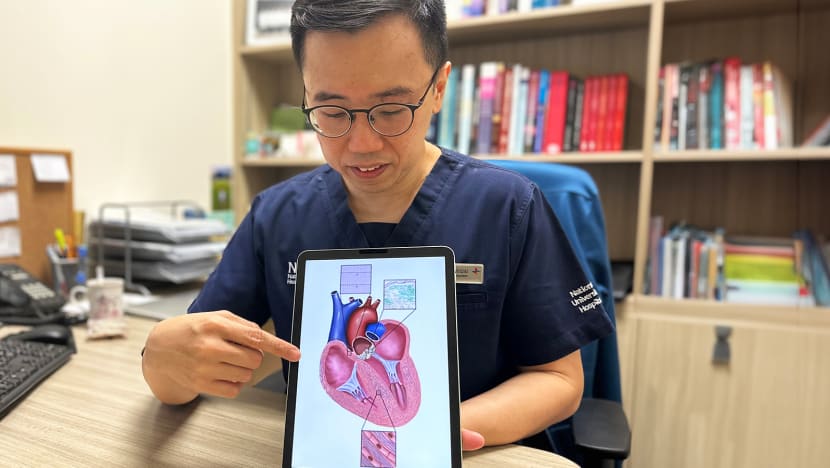Getting to the heart of a rare cardiac condition
An expert discusses transthyretin amyloid cardiomyopathy, its treatment options and the importance of patient support.

Transthyretin amyloid cardiomyopathy (ATTR-CM) is a rare but serious heart condition that can progress to heart failure without timely diagnosis and treatment. Photos: Shutterstock, National University Heart Centre Singapore

This audio is generated by an AI tool.
For many years, Mr Bryan Tan* led an active life, unaware of a silent condition developing in his heart.
It wasn’t until October 2022 that symptoms began to manifest, starting with numbness in his limbs and walking difficulties. After a battery of tests, Mr Tan was diagnosed with transthyretin amyloid cardiomyopathy (ATTR-CM) in January last year.
Since then, the condition has impacted his daily life, requiring frequent hospital visits and assistance with mobility. Even simple tasks like standing up and climbing stairs now pose a challenge.
UNDERSTANDING ATTR-CM
ATTR-CM is a rare yet serious heart disease that can lead to heart failure if not diagnosed and treated promptly. According to Assistant Professor Lin Weiqin, clinical director, Heart Failure and Cardiomyopathy Programme, and senior consultant, Department of Cardiology at National University Heart Centre Singapore (NUHCS), ATTR-CM occurs when transthyretin amyloid proteins (misfolded, insoluble proteins) deposit in the heart, disrupting its function. Symptoms are often vague and may include numbness in the hands and feet, lethargy and dizziness.
Public awareness of the disease is crucial because such symptoms are usually mistaken for more common conditions, potentially delaying timely treatment. A study published in the Journal of the American College of Cardiology found that early diagnosis significantly improves patient outcomes.
“The key to diagnosing ATTR-CM is to always to suspect it,” said Asst Prof Lin. For instance, elderly patients presenting with shortness of breath and heart failure symptoms need a thorough evaluation of their heart to identify ATTR-CM.
Diagnosing ATTR-CM typically involves an electrocardiogram, echocardiogram and blood tests. In some cases, more in-depth tests like a nuclear heart scan, which uses a small amount of radioactive material to create images of the heart, or a heart biopsy may be ordered. Asst Prof Lin added that the condition is more commonly found in the elderly and in individuals with a family history of ATTR-CM. Family screening can help identify carriers of the mutant gene who may develop the disease later in life.
To date, there are no known environmental factors that put one at a higher risk of developing ATTR-CM.
NEXT STEPS, FOLLOWING A DIAGNOSIS

The treatment of ATTR-CM depends on the patient’s symptoms. “For patients experiencing heart failure or water retention, diuretic medications are prescribed to relieve fluid overload and congestion,” shared Asst Prof Lin.
Other patients may present with an excessively slow heart rate due to transthyretin amyloid proteins disrupting the heart’s electrical conduction system. In such cases, pacemaker implantation may be necessary.
New medications developed in the last decade have shown promise in managing symptoms and improving patients’ quality of life. “We now have drugs that specifically target the process causing transthyretin amyloidosis pathogenesis (the build-up of abnormal protein). For suitable patients, these therapeutic options will be discussed and offered,” said Asst Prof Lin.
Beyond treatment, he believes that establishing patient support groups can benefit patients and caregivers. “Connecting with others in the same boat makes the journey less lonely,” he said. “Attending physicians can also direct patients and caregivers to credible resources to learn more about the condition.”
BRIDGING THE AWARENESS GAP
According to Asst Prof Lin, broader community support is vital for patients with rare heart diseases like ATTR-CM. “Raising public awareness helps avoid delayed diagnoses and missed treatment opportunities. It also encourages support from governments and non-governmental organisations for research and patient assistance programmes,” he said.
Moreover, media campaigns and educational initiatives can increase the visibility of these conditions. Personal stories like Mr Tan’s are particularly important as they enable more people to understand the challenges faced by patients with rare heart diseases.
Asst Prof Lin emphasises the need for greater recognition of underdiagnosed conditions and urges the public to be proactive. Mr Tan recommends using an online self-assessment tool to help individuals better evaluate their risk of ATTR-CM, especially those aged over 60 or with a family history of the condition.
Despite his health issues, Mr Tan endeavours to make the most of each day, drawing strength from the support of his wife and daughter. He has also found friendship and solace from global and regional support groups.

Mr Tan believes that with the right care and treatment, living gracefully with ATTR-CM is possible. He underscored the public’s role in creating a more inclusive environment. “Showing kindness can make a big difference to those with invisible and rare conditions like ATTR-CM. Whether it’s offering assistance or simply being patient, these gestures provide us immense encouragement,” he shared.
It is crucial for individuals to seek advice from healthcare professionals for early diagnosis and management. A holistic support system – encompassing medical, emotional and social aspects – is essential for patients with rare heart diseases like ATTR-CM to lead fulfilling lives.
Seek prompt medical attention if you experience limb numbness, lethargy or dizziness. Learn more about ATTR-CM.
*The patient’s name has been changed to protect his privacy.
This article is sponsored by Pfizer Singapore. The opinions expressed in this article are solely those of the expert(s), speaker(s) or participant(s) featured herein. This material is intended for educational and/or disease awareness purposes only and should not be used as a substitute for consulting a healthcare professional. For more information, speak to a healthcare professional. References are available upon request.















